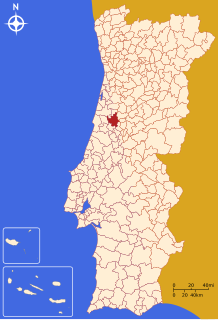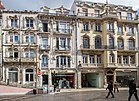Coimbra | |
|---|---|
|
Clockwise: View of Coimbra from the Mondego River; University of Coimbra; Sé Nova; Coimbra waterfront; Santa Cruz Monastery; Coimbra baixa. | |
 | |
| Coordinates: 40°12′10″N 8°24′50″W / 40.20278°N 8.41389°W | |
| Country | |
| Region | Centro |
| Intermunic. comm. | Região de Coimbra |
| District | Coimbra |
| Parishes | 18 (list) |
| Government | |
| • President | José Manuel Silva (Ind.) |
| Area | |
• Total | 319.40 km2 (123.32 sq mi) |
| Highest elevation | 499 m (1,637 ft) |
| Lowest elevation | 9 m (30 ft) |
| Population (2021) | |
• Total | 140,796 |
| • Density | 440/km2 (1,100/sq mi) |
| Time zone | UTC+00:00 (WET) |
| • Summer (DST) | UTC+01:00 (WEST) |
| Postal code | 3000 |
| Area code | 239 |
| Patron | Rainha Santa Isabel |
| Website | www |
Coimbra (/koʊˈɪmbrə/, also US: /kuˈ-, ˈkwɪmbrə/,[1][2] UK: /ˈkɔɪmbrə/,[3] Portuguese: [kuˈĩbɾɐ] or [ˈkwĩbɾɐ][4]) is a city and a municipality in Portugal. The population of the municipality at the 2021 census was 140,796,[5] in an area of 319.40 square kilometres (123.3 sq mi).[6] The fourth-largest agglomerated urban area in Portugal after Lisbon, Porto, and Braga, it is the largest city of the district of Coimbra and the Centro Region. About 460,000 people live in the Região de Coimbra, comprising 19 municipalities and extending into an area of 4,336 square kilometres (1,674 sq mi).
Among the many archaeological structures dating back to the Roman era, when Coimbra was the settlement of Aeminium, are its well-preserved aqueduct and cryptoporticus. Similarly, buildings from the period when Coimbra was the capital of Portugal (from 1131 to 1255) still remain. During the late Middle Ages, with its decline as the political centre of the Kingdom of Portugal, Coimbra began to evolve into a major cultural centre. This was in large part helped by the establishment of the first Portuguese university in 1290 in Lisbon and its relocation to Coimbra in 1308, making it the oldest academic institution in the Portuguese-speaking world. Apart from attracting many European and international students, the university is visited by many tourists for its monuments and history. Its historical buildings were classified as a World Heritage site by UNESCO in 2013: "Coimbra offers an outstanding example of an integrated university city with a specific urban typology as well as its own ceremonial and cultural traditions that have been kept alive through the ages."[7]
- ^ "Coimbra". The American Heritage Dictionary of the English Language (5th ed.). HarperCollins. Retrieved 23 July 2019.
- ^ "Coimbra". Merriam-Webster.com Dictionary. Merriam-Webster. Retrieved 23 July 2019.
- ^ "Coimbra". Lexico UK English Dictionary. Oxford University Press. Archived from the original on 22 March 2020.
- ^ Wells, John C. (21 July 2010). "Portuguese". Archived from the original on 1 December 2017. Retrieved 17 June 2012.
- ^ "Conheça o seu Município". www.pordata.pt. Retrieved 8 December 2023.
- ^ "Áreas das freguesias, concelhos, distritos e país". Archived from the original on 5 November 2018. Retrieved 5 November 2018.
- ^ "University of Coimbra – Alta and Sofia". unesco.org. UNESCO. Archived from the original on 12 July 2018. Retrieved 13 December 2016.







